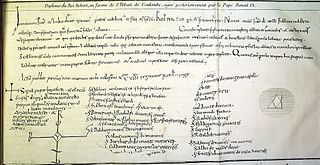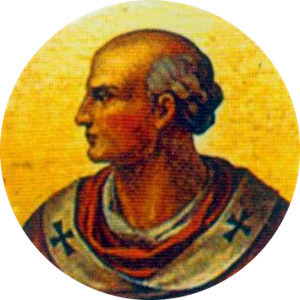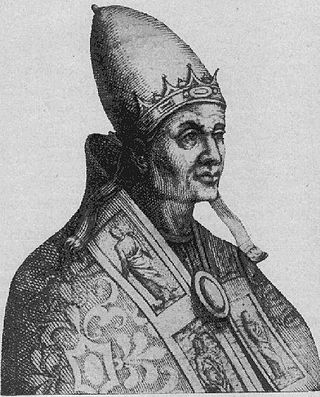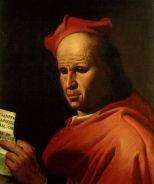Related Research Articles

Pope Agapetus II was the bishop of Rome and ruler of the Papal States from 10 May 946 to his death. A nominee of the princeps of Rome, Alberic II of Spoleto, his pontificate occurred during the period known as the Saeculum obscurum.
Pope Benedict III was the bishop of Rome and ruler of the Papal States from 29 September 855 to his death.

Pope Benedict V was the pope and ruler of the Papal States from 22 May to 23 June 964, in opposition to Leo VIII. He was overthrown by Emperor Otto I. His brief pontificate occurred at the end of a period known as the Saeculum obscurum.

Pope Benedict IX, born Theophylactus of Tusculum in Rome, was the bishop of Rome and ruler of the Papal States for three periods between October 1032 and July 1048. Aged about 20 when first elected, he is the youngest pope in history. He is the only person to have been Pope more than once and the only person ever accused of selling the papacy.
Pope Stephen VIII was the bishop of Rome and nominal ruler of the Papal States from 14 July 939 to his death. His pontificate occurred during the Saeculum obscurum, when the power of popes was diminished by the ambitious counts of Tusculum, and was marked by the conflict between his patron, Alberic II of Spoleto, and King Hugh of Italy.
Pope Stephen IX was the Bishop of Rome and ruler of the Papal States from 3 August 1057 to his death on 29 March 1058. He was a member of the Ardenne-Verdun family, who ruled the Duchy of Lorraine, and started his ecclesiastical career as a canon in Liège. He was invited to Rome by Pope Leo IX, who made him chancellor in 1051 and one of three legates to Constantinople in 1054. The failure of their negotiations with Patriarch Michael I Cerularius of Constantinople and Archbishop Leo of Ohrid led to the permanent East–West Schism. He continued as chancellor to the next pope, Victor II, and was elected abbot of the Benedictine monastery of Montecassino.
Pope Sergius III was the bishop of Rome and nominal ruler of the Papal States from 29 January 904 to his death. He was pope during a period of violence and disorder in central Italy, when warring aristocratic factions sought to use the material and military resources of the papacy. At the behest of Theophylact I of Tusculum, Sergius seized the papal throne from Antipope Christopher, who in turn had deposed Pope Leo V. Sergius' reign was subsequently marked by Theophylact's influence. As pope, Sergius continued many ecclesiastical controversies of his predecessors, including conflict over Pope Formosus' legacy, annulling all ordinations made by the late pope, and the filioque controversy with eastern patriarchs. His pontificate was similarly marked by temporal conflicts, with Sergius' refusal to crown Berengar I of Italy as Holy Roman Emperor, and his support of Byzantine Emperor Leo VI the Wise's fourth marriage. Sergius also saw the restoration of the Lateran Palace.
Pope Damasus II was the Bishop of Rome and ruler of the Papal States from 17 July 1048 to his death on 9 August that same year. He was the second of the German pontiffs nominated by Emperor Henry III. A native of Bavaria, he was the third German to become pope and had one of the shortest papal reigns.

Benedict X, born Giovanni, was elected to succeed Pope Stephen IX on 5 April 1058, but was opposed by a rival faction that elected Nicholas II. He fled Rome on 24 January 1059 and is today generally regarded as an antipope.

Pope John XII, born Octavian, was the bishop of Rome and ruler of the Papal States from 16 December 955 to his death in 964. He was related to the counts of Tusculum, a powerful Roman family which had dominated papal politics for over half a century. He became pope in his late teenage years or early twenties. In 960, he clashed with the Lombards to the south. Unable to control Rome easily, he sought help from King Otto I of Germany and crowned him emperor. John XII's pontificate became infamous for the alleged depravity and worldliness with which he conducted his office. He soon fell out with Otto, but died before Otto could succeed in his attempt to depose him.
Pope John XI was the bishop of Rome and nominal ruler of the Papal States from March 931 to his death. The true ruler of Rome at the time was his mother, Marozia, followed by his brother Alberic II. His pontificate occurred during the period known as Saeculum obscurum.
Pope John X was the bishop of Rome and nominal ruler of the Papal States from March 914 to his death. A candidate of the counts of Tusculum, he attempted to unify Italy under the leadership of Berengar of Friuli, and was instrumental in the defeat of the Saracens at the Battle of Garigliano. He eventually fell out with Marozia, who had him deposed, imprisoned, and finally murdered. John’s pontificate occurred during the period known as the Saeculum obscurum.
Honorius II, born Pietro Cadalo, was an antipope from 1061 to 1072. He was born in the County of Verona, and became bishop of Parma in 1045. He died at Parma in 1072.
Theophylact I was a medieval count of Tusculum who was the effective ruler of Rome from around 905 through to his death in 924. His descendants controlled the papacy for the next 100 years.
The Battle of Garigliano was fought in 915 between Christian forces and the Saracens. Pope John X personally led the Christian forces into battle. The aim was to destroy the Arab fortress on the Garigliano River, which had threatened central Italy and the outskirts of Rome for nearly 30 years.

The counts of Tusculum, also known as the Theophylacti, were a family of secular noblemen from Latium that maintained a powerful position in Rome between the 10th and 12th centuries. Several popes and antipopes during the 11th century came from their ranks. They created and perfected the political formula of noble-papacy, wherein the pope was arranged to be elected only from the ranks of the Roman nobles. The Pornocracy, the period of influence by powerful female courtesans of the family, also influenced papal history.

Matteo Orsini was an Italian Dominican friar and Cardinal.
The October 1187 papal election was convoked after the death of Pope Urban III. He and the papal court had escaped from the imperial blockade of Verona only the month before, and had taken refuge in Ferrara. The election, held in Ferrara the day after the pope's death, resulted in the election of Cardinal Alberto Sartori di Morra, who took the name of Gregory VIII. He was a partisan of the Emperor Frederick Barbarossa, whose election delighted him. Gregory VIII reigned only two months.

The Tusculan Papacy was a period of papal history from 1012 to 1048 where three successive relatives of the counts of Tusculum were installed as pope.

Raniero Capocci, also known as Ranieri, Rainier, or Rainerio da Viterbo was an Italian cardinal and military leader, a fierce adversary of emperor Frederick II.
References
- 1 2 Heidecker, Karl Josef (2010). The Divorce of Lothar II: Christian Marriage and Political Power in the Carolingian World . Cornell University Press. p. 41 n.18. ISBN 9780801439292.
- ↑ Howe, John (1997). Church Reform and Social Change in Eleventh-Century Italy: Dominic of Sora and His Patrons. Philadelphia: University of Pennsylvania Press. p. 25 n.4.
- ↑ Fried, Johannes (2007). Donation of Constantine and Constitutum Constantini: The Misinterpretation of a Fiction and its Original Meaning. Walter de Gruyter. p. 46.
- ↑ Gregorovius, The History of the City of Rome in the Middle Ages (Rome: 1905), V, 8.
- ↑ Duckett, Eleanor Shipley (1968). Death and Life in the Tenth Century. Ann Arbor: University of Michigan Press. p. 138.
- Editions
- Giuseppe Zucchetti, ed. Il Chronicon di Benedetto, monaco di S. Andrea del Soratte e il "Libellus de imperatoria potestate in urbe Roma", Fonti per la storia d'Italia, 55. Rome: 1920.
- Georg Pertz, ed. "De imperatoria potestate in urbe Roma libellus", Mon. Germ. Hist. Scriptores, iii, 719–22.
- Further reading
- Ferdinand Hirsch, "Die Schenkung Kaiser Karls des Kahlen für Papst Johann VIII und der Libellus de imperatoria potestate in urbe Roma", Forschungen sur deutschen Geschichte, 20.
- Marios Costambeys, Power and Patronage in the Early Medieval Italy: Local Society, Italian Politics, and the Abbey of Farfa, c.700–900. Cambridge: Cambridge University Press, 2007.